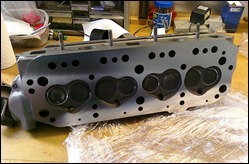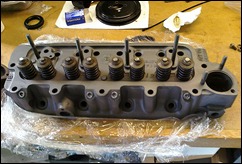Great weather for chores this weekend and VW TDI diagnosis
Posted By RichC on October 16, 2011
The weekend was a good one weather-wise for yard chores and closing up the pool. Beside meeting our son Taylor for lunch on Saturday, Brenda and I took advantage of the nice warm autumn weather and enjoyed both Saturday and Sunday outside.
I also was able to retrieve the heads from the MGB that Jack Cook of Cook’s Engine Service in Mason machined for me. It looks as if he did a great job, but then I suspect 40 years in the business has him knowing what he is doing … we’ll see once I put things back together.
Sunday afternoon also gave me a chance to get together with a couple VW TDI guys and using the Vagcom and computer to help diagnosis an EGR valve issue. I’m going to archive the eventual replacement how to page below for both Tim and Matt.
How to remove the intake manifold, intake flap, or EGR on VW Passat TDI
Introduction
This article shows how to remove a clogged intake for cleaning, along with the throttle intake flap and EGR valve.
Unlike earlier Volkswagen TDI, the intake manifolds on pumpe duse engines don’t seem to get as soot clogged. See 1000q: direct injection and pumpe duse vs. common rail for more information on the TDI engines. This is partly due to ultra low sulfur diesel fuel in the US and more accurate EGR metering.
Parts
intake manifold gasket: VW# 028 129 717 d
intake manifold bolts: VW# n 902 006 04
6mm egr bolts: : VW# n 910 488 01
intake manifold paper egr cooler gasket (quantity 1): VW# 069 131 547 d
metal egr cooler gaskets (quantity 3) VW# 038 131 547 a
intake regulating flap: VW# 03g 128 063 j
o-ring: VW# n 905 216 01 (new flap includes one)
egr valve: VW# 038 131 501 ad
o-ring VW# n 900 627 02 (new egr includes one)
TDI engine intake manifold removal procedure
Remove the engine cover (3x 10mm nuts). The EGR and intake flap can be removed separately from the intake manifold if they need replacement.
EGR removal
Here is the EGR valve removed and after cleaning. It rotates to block or divert EGR gasses into the intake manifold.


To remove only the EGR, remove the 3x 5mm allen head bolts (2 are circled in yellow below). After it’s loose, rotate it a little to break the seal. Vacuum any loose carbon bits out of the intake manifold. At the bottom of this page is a picture of a bare intake manifold with the EGR removed.

Intake flap removal (the thing highlighted in blue in the above picture)
Remove the plastic intake hose and hose spring clip. The flap is held on by 3x 8mm triple square bolts. There’s an o-ring between the flap and intake manifold.

Intake manifold removal
Remove the engine cover (3x 10mm bolts). You can convert it to a pop off socket so that you can just pull it off, see 1000q: engine pop off cover mod for more details. It’s for a Jetta but it’s the same procedure.
Remove the air intake snorkel (3x phillips screws) and air filter box cover (2x phillips screws). Remove the engine air filter box (1x 10mm bolt, hose clamp, unplug the MAF sensor). Remove the air intake tube (1 hose clamp or 1 spring clip)/

Remove the 2 EGR metal hoses connecting the exhaust manifold-EGR cooler and EGR cooler-intake manifold. 2x 6mm allen head bolts each end, the location of some of these are circled below and are visible in the above and below picture. The lower metal EGR was already removed in the below picture.

Then remove the upper and left EGR cooler bolt (blue arrows in the above pic). The cooler is the round metal thing that has coolant hoses on it. The lower right bolt is blocked by the VNT actuator so you have to remove the 6x 6mm intake manifold bolts to remove it. Then pivot the manifold, giving access to that bolt.
Pivot the EGR cooler out of the way and you should have enough clearance to remove all the intake manifold bolts (yellow arrows below)

Vacuum out any loose carbon. Do not let chunks fall into the engine since it could pass through the turbo and cause damage.

Here is a cleaned bare intake manifold. You can soak it in biodiesel or another strong solvent to clean carbon off. You could also spray carb cleaner into it and scrape loose carbon off and then clean it again. A thin hacksaw blade or pipe brush can help reach the corners.


I use a pressure washer to clean the manifold – the carwash type pressure washers aren’t strong enough to blast much carbon off. Pictured below is another intake manifold and some clamps holding it for cleaning. Be very careful of pressure washers because they can cause serious injury if you’re hit by the jet of water!
Another method is to burn the buildup out. It’s mostly carbon and unburned fuel and oil turned into glue. Below is a video from a third party site showing this. I strongly recommend that you remove the EGR and all plastic parts off the aluminum manifold before heating it or else the EGR can be damaged. It’s also a potentially serious fire hazard so make sure there is nothing flammable nearby, take all precautions to avoid getting burned, let it cool before handling, see the TOS Agreement for the full legal disclaimer. The fumes are also bad for you to inhale and bad for the environment to have raw soot and oil burning off so make sure you take all precautions to prevent inhaling the smoke.



Comments